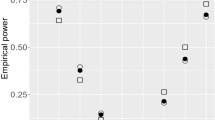Abstract
A new area of research interest is the computation of exact confidence limits or intervals for a scalar parameter of interest θ from discrete data by inverting a hypothesis test based on a studentized test statistic. See, for example, Chan and Zhang (1999), Agresti and Min (2001) and Agresti (2003) who deal with θ a difference of binomial probabilities and Agresti and Min (2002) who deal with θ an odds ratio. However, neither (1) a detailed analysis of the computational issues involved nor (2) a reliable method of computation that deals effectively with these issues is currently available. In this paper we solve these two problems for a very broad class of discrete data models. We suppose that the distribution of the data is determined by (θ,ψ) where ψ is a nuisance parameter vector. We also consider six different studentized test statistics. Our contributions to (1) are as follows. We show that the P-value resulting from the hypothesis test, considered as a function of the null-hypothesized value of θ, has both “jump” and “drop” discontinuities. Numerical examples are used to demonstrate that these discontinuities lead to the failure of simple-minded approaches to the computation of the confidence limit or interval. We also provide a new method for efficiently computing the set of all possible locations of these discontinuities. Our contribution to (2) is to provide a new and reliable method of computing the confidence limit or interval, based on the knowledge of this set.
Similar content being viewed by others
References
Adjuik, M., et al. 2002. Amodiaquine-artesunate versus amodiaquine for uncomplicated Plasmodium falciparum malaria in African children: A randomised, multicentre trial. The Lancet 359: 1365–1372.
Agresti, A. 2003. Dealing with discreteness: Making ‘exact’ confidence intervals for proportions, differences of proportions, and odds ratios more exact. Statistical Methods in Medical Research 12: 3–21.
Agresti, A. and Min, Y. 2001. On small-sample confidence intervals for parameters in discrete distributions. Biometrics 57: 963–971.
Agresti, A. and Min, Y. 2002. Unconditional small-sample confidence intervals for the odds ratio. Biostatistics 3: 379–386.
Chan, I.S.F. and Zhang, Z. 1999. Test-based exact confidence intervals for the difference of two binomial proportions. Biometrics 55: 1202–1209.
Cox, D.R. and Hinkley, D.V. 1974. Theoretical Statistics. Chapman & Hall, London.
Farrington, C.P. and Manning, G. 1990. Test statistics and sample size formulae for comparative binomial trials with null hypothesis of non-zero risk difference or non-unity relative risk. Statistics in Medicine 9: 1447–1454.
Kabaila, P. and Lloyd, C.J. 1997. Tight upper confidence limits from discrete data. Austral. J. Statist. 37: 193–204.
Miettinen, O. and Nurminen, M. 1985. Comparative analysis of two rates. Statistics in Medicine 4: 213–226.
Santner, T.J. and Snell, M.K. 1980. Small-sample confidence intervals for p1 − p2 and p1/p2 in 2 × 2 contingency tables. Journal of the American Statistical Association 75: 386–394.
Santner, T.J. and Duffy, D.E. 1989. The Statistical Analysis of Discrete Data. Springer-Verlag, New York.
Author information
Authors and Affiliations
Rights and permissions
About this article
Cite this article
Kabaila, P. Computation of exact confidence intervals from discrete data using studentized test statistics. Stat Comput 15, 71–78 (2005). https://doi.org/10.1007/s11222-005-4791-y
Received:
Accepted:
Issue Date:
DOI: https://doi.org/10.1007/s11222-005-4791-y



